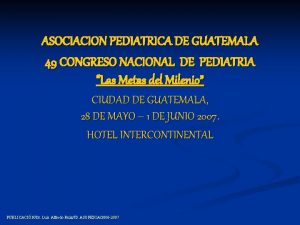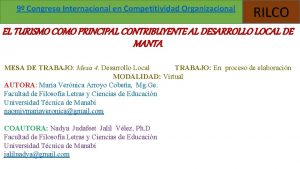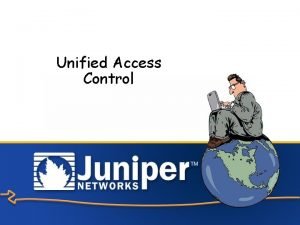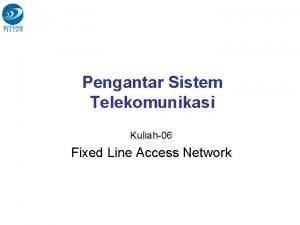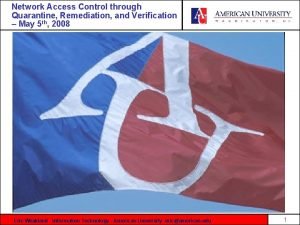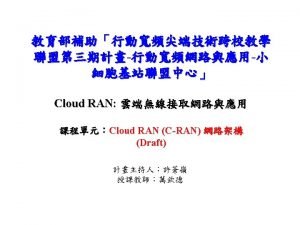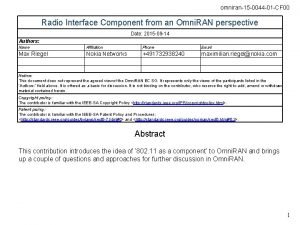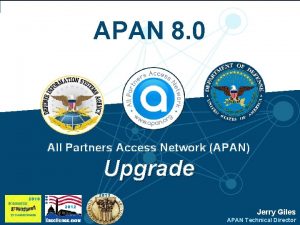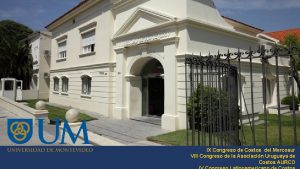Congreso TEPAL 2017 Comcasts Access Network Strategy Jorge
















- Slides: 16

Congreso TEPAL - 2017 Comcast’s Access Network Strategy Jorge Salinger VP, Access Architecture CONFIDENTIAL AND PROPRIETARY COMCAST

Comcast’s Access Network Plan Components • DOCSIS® 3. 1 – Gigabit to 100% of homes via HFC • Fiber Deep – More cost effective than node splits and FTTH – Additional capacity for DOCSIS 3. 1 • Distributed Architectures – More efficient HE architecture and better DOCSIS 3. 1 performance • Full Duplex DOCSIS – Enable multi-gigabit upstream capacity • Fiber to the Home/Premise – Resi new build, RFo. G/10 G EPON/NG EPON, biz Metro. E services, 2 Gig CONFIDENTIAL AND PROPRIETARY COMCAST 2

Few 1. 0/1. 1 Lots of 2. 0 Some 3. 0 Remove 1. 0/1. 1 More 3. 0 Many 3. 0 Begin deploy 3. 1 Initial D 3. 0 Broad D 3. 0 3. 1 CPE 5 -42/65 MHz US 3. 0 CMTS DS Bonding Legacy OOB 3. 0 CCAP More DS Bonding US Bonding S-CDMA 3. 0 CCAP More DS & US bonding Lots of 3. 0 More 3. 1 Lots of 3. 1 DS CCAP 3. 1 US CCAP 3. 1 CCAP Begin 3. 1 DS Expand DS Begin 3. 1 US OFDMA Here now HE Equipment CPE Devices DOCSIS® 3. 1 Deployment Underway at Comcast CONFIDENTIAL AND PROPRIETARY COMCAST 3

Comcast’s Focus on DOCSIS 3. 1 • Target DOCSIS 3. 1 to 100% of the Comcast footprint ◦ Very large plan in execution across all regions ◦ 35% in 2016 - 70% in 2017 – rest in 2018 • Started deployment with XB 6 gateway ◦ Initiated deployment in 2016 with TC 4400 -CMT • Service installation tools are very important ◦ New tools to measure OFDM channel performance ◦ Optimize CCAP config with Profile Management System ◦ Technical & operational changes from DOCSIS 3. 0 • Training is fundamental to develop understanding ◦ Qualify customer’s equipment ◦ Provide speed testing capable of Gigabit speeds CONFIDENTIAL AND PROPRIETARY COMCAST 4

Fiber Deep: Primary HFC Evolution Tool Passive coax More spectrum Flexible spectrum Smaller serving groups Convenient access for FTTP Cost effective long-term approach CONFIDENTIAL AND PROPRIETARY COMCAST 5

Fiber Deep 85 MHz Mid-Split – Customer Trial Live Today • October 2016 kicked-off in West Division • Use of “Special’ 85 MHz-capable XB 3 • First actual use of >42 MHz with XB 6 availability (switchable diplexer) • Estimate in 2 H ‘ 17 will have the capability to offer a 100 Mbps services in Fiber Deep markets to D 3. 1 1 G customers CONFIDENTIAL AND PROPRIETARY COMCAST 6

Fiber Deep is Awesome. . . But. . . • • Architecture +10 x Fiber Deep nodes Very small service groups Very efficient for narrowcast Fiber within 1 K ft of homes Space Utilization Current Approach ~10 Racks All-in Today Fiber Deep CCAP Gen 1 Line Cards 3 x To 4 x RPHY or RMACPHY Plus HW Core Less Than Today RPHY or RMACPHY Plus Virtualized Core Even Less Space DAA Today Non-Fiber Deep Gen 1 Line Cards ü Significant Scalability of Facilities ü Fiber Efficiency and Better Performance ü Simplicity of Ethernet Connectivity CONFIDENTIAL AND PROPRIETARY COMCAST 7

STRATEGIC PIVOT TO DISTRIBUTED ACCESS (DAA) Distributed Access Ethernet Connectivity Fiber Reach Fiber Efficiency Virtualized Distributed Access D 3. 1 Performance Alignment to NFV / SDN Transition Scalability of Facilities Last Mile Access Agnostic CONFIDENTIAL AND PROPRIETARY COMCAST 8

Phases and Aspects of R-PHY Development 1. Base Implementation Develop RPD Separate PHY RPD/R PS Core Implement Interfaces Timing Control plane Data plane 3. Two Use Cases Fiber Deep RPD Core RPD BAU HFC 2. Core-RPD/RPS Interoperability CMTS Core 1 Same Interfaces RPD 1 CMTS Core 2 RPD 2 v. CMTS RPD 3 • Address non-vendorspecific interaction • No exact match of CCAP, Node and Encryption footprint • Need one vendor’s RPHY with another vendor’s Core 4. Generations • Features for each case • Spectrum difference DS and US • Capacity and performance differences • Different device architecture In Progress 2018 / 2019 Gen 1 Gen 2 Gen 3 • Current silicon • Designed to support FDX • Optimize components & power • Already in Development • Mid-2017 initial field trial and deploy late ’ 17 • Eventually implement RDK-n • Available C O N F I D E N T I A L A N D P R O P R I E T A R Y C O M C A S T ASAP 2019 9

Remote PHY Development in Progress • Comcast working with multiple vendors since 1 Q 16 • Work underway to implement interfaces and develop operational functionality • Have nodes and cores from multiple vendors in multiple labs • Comcast Targets: • Trials in 3 Q 17, Small-scale deployment in 4 Q 17, Full-scale by 1/1/18 • Cable. Labs Interops underway since November, 2016 • Monthly events (6 th next week) • Extensive GCP, R-DTI and DEPI, some UEPI • OOB implementation well underway • SCTE 55 -1 DS with all vendors and US with 2 vendors • Code from Broadcom; now scaling • Leakage Detection also well underway • Working Group with several node/CMTS vendors and tool companies • Specified RPD requirements for all participating vendors CONFIDENTIAL AND PROPRIETARY COMCAST 10

Remote PHY Development in Progress • Spectrum Surveillance work underway • Replacement for tools such as Path. Track; monitor US for ingress detection • Started work on Sweep (FWD and RTN) • Need to be compatible with field tech tools • Developing test/integration tools • Ethernet Sniffer: • Monitor and debug interface between CMTS Core and RPD • Comcast funded; in use by all vendors and Cable. Labs; available to everyone • RPD Reference Design • Based on Open. RPD – not required for interoperability • Intended for positive and negative testing of CMTS Cores • Core Reference Design • 3 Approaches Available: Broadcom Triton/Atlas, Vector Emulator, Tool from Altera/Capacicom • Intended for positive and negative testing of RPDs 11 CONFIDENTIAL AND PROPRIETARY COMCAST

Fiber Deep + RPHY: Enabler of “Full Duplex” DOCSIS • Key dependencies are Comcast Po. R üPassive Coax (i. e. Fiber Deep) üDistributed Architecture (DAA) üTransition to All-IP üDOCSIS 3. 1 deployment plan • Key Objectives ‒ Order of magnitude improvement in upstream capacity and speeds without extending split into Downstream spectrum ‒ Services agnostic to last mile access technology or medium ‒ Integrate with Fiber Deep DAA deployments ASAP ‒ Gig Symmetric competitive - Brownfield MDU, future Io. T capacity Key Upcoming Activities 3 Q’ 16 4 Q’ 16 MSO Requirements Finalized 1 Q’ 17 2 Q’ 17 FDX Standards Finalized 3 Q’ 17 4 Q’ 17 1 Q’ 18 2 Q’ 18 Proposed Maxlinear ASIC availability FDX Cable. Labs Kickoff CONFIDENTIAL AND PROPRIETARY COMCAST 3 Q’ 18 4 Q’ 18 2019 Silicon Ready for Testing Gig US / HFC 12

Motivation • DOCSIS 3. 1 provides multi-gigabit downstream, now in deployment ◦ Competition drove message for gigabit symmetrical services ◦ Full Duplex adds the remaining piece – multi-gigabit US • Full Duplex provides significantly more US capacity ◦ Enables multi-gigabit symmetrical data services from 1 st generation • No need to move the split to expand US capacity ◦ Keep existing DOCSIS services in the low part of the spectrum • Backwards compatible with deployed DOCSIS ◦ Upgrade on a success basis, keeping other deployed devices • Existing technology, now applicable to HFC ◦ Previously considered, but only now seemingly feasible CONFIDENTIAL AND PROPRIETARY COMCAST 13

Assumptions for Full Duplex Operation • Plant ◦ Passive HFC network for Full Duplex DOCSIS (Fiber Deep, N+0) ◦ Fiber Deep node contains a DAA module (R-PHY or R-MACPHY) ◦ Highest possible port-to-port tap isolation ◦ FDX CPE terminates HFC network • Spectrum ◦ FDX uses D 3. 1 downstream and new upstream channel definition ◦ FDX US transmissions use spectrum allocated to DOCSIS 3. 1 DS ◦ Spectrum allocated to QAM video or legacy DOCSIS not used for FDX • FDX CM receives OR transmits at any time • DAA/CMTS simultaneously receives and transmits CONFIDENTIAL AND PROPRIETARY COMCAST 14

Synergistic Relationships More evolution in the access network now and in 2 -3 years than in the past 20 years !! CONFIDENTIAL AND PROPRIETARY COMCAST 15 15

Questions? Thank You ! Jorge Salinger VP, Access Architecture jorge_salinger@cable. comcast. com CONFIDENTIAL AND PROPRIETARY COMCAST 16
 Mural del congreso nacional
Mural del congreso nacional Características de congreso
Características de congreso Asopedia congreso
Asopedia congreso Rilco
Rilco Primer congreso
Primer congreso Government ict strategy and action plan to 2017
Government ict strategy and action plan to 2017 Infor ion bi
Infor ion bi Terminal access controller access control system plus
Terminal access controller access control system plus Terminal access controller access-control system
Terminal access controller access-control system Unified access control
Unified access control Fixed network adalah
Fixed network adalah Network access quarantine control
Network access quarantine control Community health access network
Community health access network Simultaneous access in network
Simultaneous access in network Centralized radio access network
Centralized radio access network Access network architecture
Access network architecture All partners access network
All partners access network


